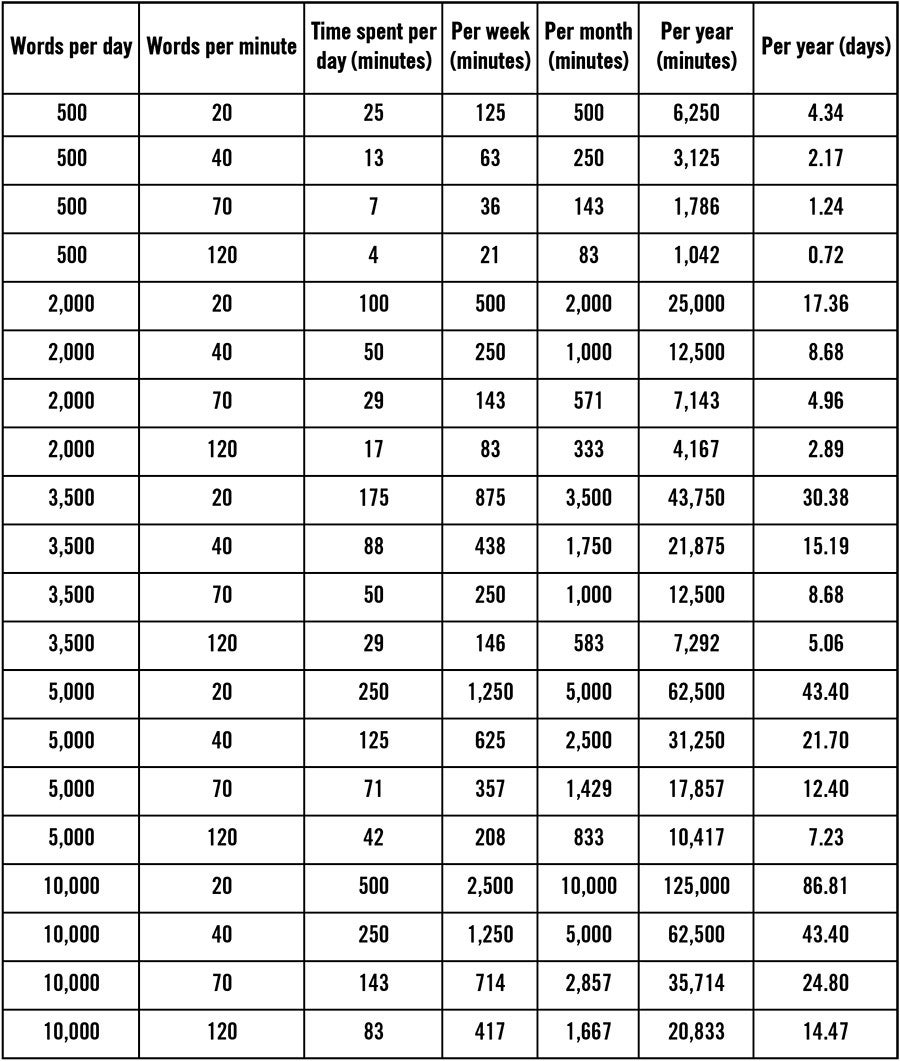It was recently brought to my attention that two of my colleagues here at MEL don’t know how to type. That is, rather than memorizing the keyboard and engaging it with all 10 fingers (aka “touch-typing”), they use the “hunt-and-peck” method, searching visually for the correct keys to hit and striking them only with their index fingers.
Obviously, traditional typing is becoming less common as more digital communication migrates to mobile devices. But many of us still work office jobs that require us to bang away on a tabletop computer, or at least find it easier to draft a long document with a physical keyboard. And it’s here that memorizing the keyboard and engaging it with all five fingers pays huge, time-saving dividends.
Or does it? I entered this exploration thinking touch-typists like me were saving themselves years of free time with our superior methods, but after doing the math, I’ve discovered how you type isn’t necessarily an indicator of how fast you type. Speed, though, very much matters. And there are significant gains to be earned by learning to type faster.
Let’s Figure Out How Many Words You Type Per Day
Stephen King famously said professional writers should compose at least 2,000 original words a day. Similarly, a discussion between Web 1.0 bloggers found they cranked out anywhere between 1,000 and 2,500 words per day.
But that’s 2,000-plus words of finely polished prose. It doesn’t account for all the words written and deleted in the process. Nor does it consider all the typing that occurs outside the writing process. And most of us aren’t professional writers, anyway.
Information on how many words the average office worker bangs out per day has proven elusive. A 2016 U.K. study found British workers send an average of 33 emails a day, but didn’t specify how many words are contained in an average email. A separate study of British workers found they spend more than a quarter of their day, or 13 hours a week, sending and receiving emails, but again didn’t record how many typed words that totaled.
For the sake of our analysis, let’s suppose the average email is 75 words (or about six sentences) long. That should account for the cursory, “Okay. Thanks!” replies we send to colleagues, as well as the several paragraph-reports we send to our superiors and outside clients. At 75 words per email, and 33 emails per day, we get 2,475 typed words per day.
Still, this doesn’t include for all the non-email communication that occurs in a typical workday — the Slack messages, Gchats (RIP), tweets, Facebook updates and iMessages we send from our desk- and laptops—or the words we type while using PowerPoint, Word or Google Docs.
For the sake of argument, let’s say the average worker types 3,500 words a day (all things considered), with 2,000 and 5,000 words per day being slightly below and above average, respectively. And just for good measure, let’s suppose there are super communicators out there who do nothing but exchange words or prepare long-winded TPS reports all day, totaling some 10,000 words a day, as well as digital hermits who write a sparse 500 words a day.
Then, Let’s Figure Out the Average Typing Speed
LiveChat — which provides instant message, customer service software to other companies — offers a free typing test, and claims that the average person types between 38 and 40 WPM, with professional typists coming in between 65 and 75 WPM. The dispersion of scores, however, shows that most people exist within the 20 to 45 WPM range.

Advanced typists tend to top out at 120 words per minute, according to LiveChat and typing enthusiasts, but there are some outliers. Sean Wrona won a speed-typing competition at SXSW in 2010, recording a score of 163 WPM. (He claims his peak speed is more than 200.) Barbara Blackburn was the the world’s fastest typist when she appeared on Late Night with David Letterman in 1985, clocking in at a blistering 212 WPM.
But what about those inefficient two-finger typists? Turns out they’re not that slow relatively speaking. The two hunt-and-peck typists in the MEL office astonished the staff with above-average typing speeds of 41 and 49 WPM in the LiveChat test. (I mostly scored in the low-to-mid 60s, with a high score of 74 WPM.) Some Reddit users claim to type more than 90 WPM using hunt-and-peck, while their typing speed went down after transitioning from two fingers to 10.
Here’s a video of a guy typing 133 wpm with two fingers and a thumb, for instance:
This isn’t just people bullshitting on the internet, either. A 2016 study conducted by researchers in Finland found typists could achieve speeds of more than 70 WPM, regardless of the number of fingers they used. Granted, it was a very small sample size of just 30 people. But that and the anecdotal evidence cited above suggest that hunt-and-peck can be just as efficient as touch-typing in some cases.
You Could Still Save Weeks Learning How to Type Even Faster
Using the data referenced above, we did the math on how much time different people spend typing, assuming a five-day work week, 20 work days per month and 250 work days a year.

If you’re an average typist (4o WPM) who cranks out 2,000 words per day on average, you could save yourself four whole days a year by increasing your speed to an above-average 70 WPM.
The returns on typing speed are even greater the more words you type in a typical workday. At 3,500 words per day, the difference between an average typer and an above average one is seven days, an extra week of time to spend how you will. At 5,000 words per day, it’s nine days—almost two weeks of vacation. At 10,000 words, it’s 19 days, nearly an entire month of work.
And this is just at work. Imagine all the additional time you’d save when you factor in your personal communications.
So the dividends on learning to type are enormous when you think about them over the span of an entire career, especially when you can improve with just five minutes of practice a day.
